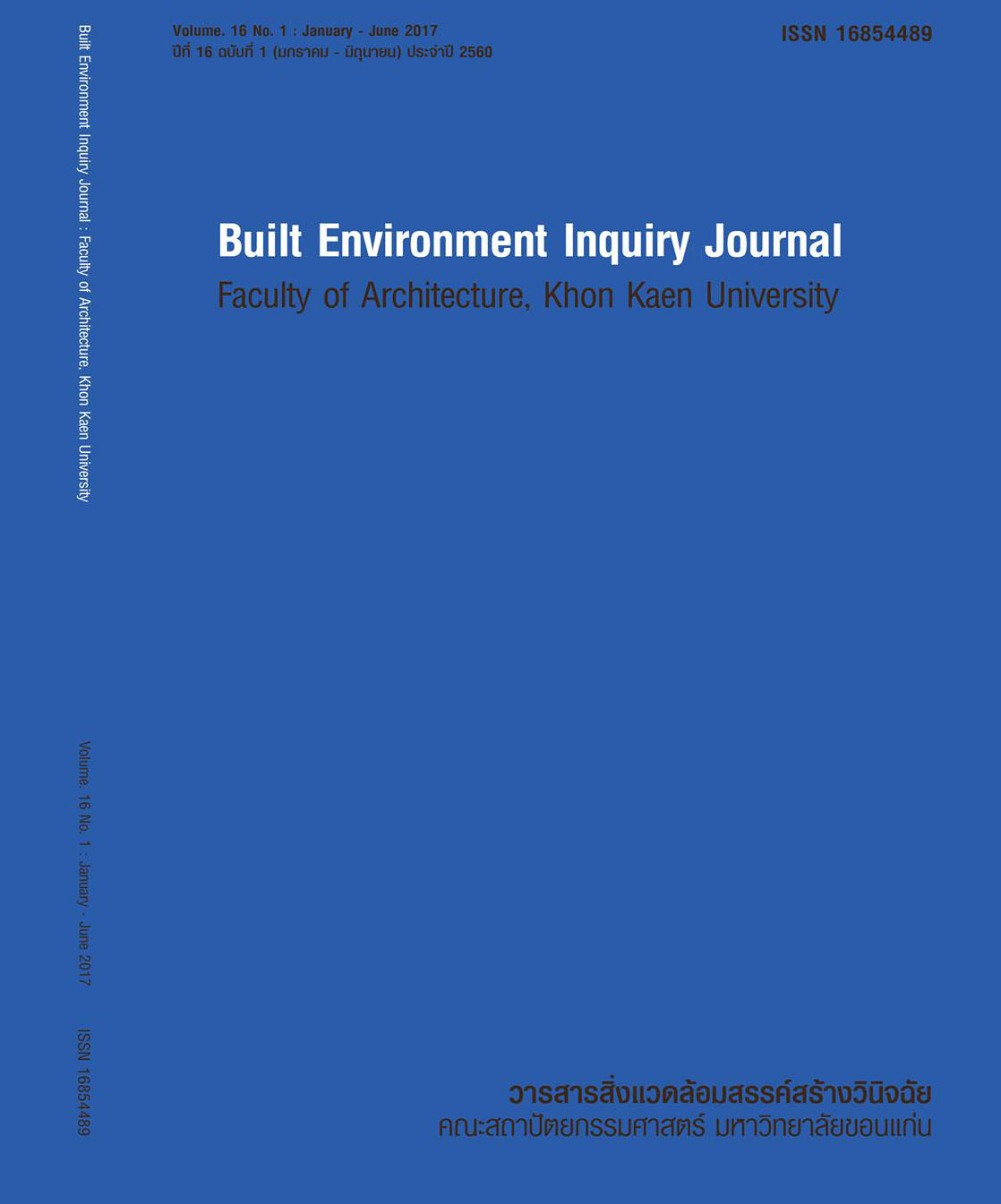ความรู้สึกเป็นสถานที่ของชุมชนละแวกบ้านในเขตเมืองประวัติศาสตร์เชียงใหม่ A ‘Sense of Place’ of the Neighbourhoods in Historic Cities: The Case of Chiang Mai, Thailand
คำสำคัญ:
Historic City, Sense of Place, Neighbourhood Characteristics, Chiang Mai, เมืองประวัติศาสตร์, ความรู้สึกเป็นสถานที่, ลักษณะเฉพาะของชุมชนละแวกบ้าน, เชียงใหม่บทคัดย่อ
บทคัดย่อ
บทความวิจัยนี้เป็นส่วนแรกของชุดโครงการวิจัยเกี่ยวกับ ความแตกต่างของ “ความรู้สึกเป็นสถานที่”
โดยนักออกแบบ-นักวางผังเมือง กับประชาชนคนท้องถิ่น เนื่องจาก “ความรู้สึกเป็นสถานที่” นับว่าเป็นปัจจัยส????ำคัญ
ในการออกแบบและวางผังเมือง แต่บริบทของกระบวนการออกแบบและวางผังเมืองโดยภาครัฐของไทย มักไม่ให้
ความส????ำคัญกับประสบการณ์ และ “ความรู้สึกเป็นสถานที่” ที่เกิดจากคนท้องถิ่น
บทความนี้เน้นที่การตรวจสอบชุมชนละแวกบ้านในเมืองประวัติศาสตร์เชียงใหม่ ทางภาคเหนือของ
ประเทศไทย การศึกษาได้ใช้วิธีการของ Punter (1991) ในการส????ำรวจโดยนักวิจัยในฐานะนักออกแบบและวางผังเมือง
ท้องถิ่นเพื่อขีดขอบเขตและสะท้อนลักษณะเฉพาะของชุมชนละแวกบ้านในเขตพื้นที่ศึกษา ปัจจัยที่ใช้ในการตัดสินใจ
สามประการได้แก่ กิจกรรม (Activities) องค์ประกอบทางกายภาพ (Physical Attributes) และความหมาย
(Meanings) การศึกษานี้ชี้ให้เห็นว่า การเปลี่ยนแปลงองค์ประกอบทางกายภาพย่อมมีผลต่อกิจกรรมที่สามารถเกิดขึ้น
ในพื้นที่ได้ และส่งผลต่อความหมายของพื้นที่นั้นที่มีต่อคนด้วย นอกจากนี้กลุ่มคนที่อยู่บนพื้นที่ใดๆ ยังมีส่วนในการ
ก????ำหนด “ความรู้สึกเป็นสถานที่” ของสถานที่นั้นๆ ด้วย ดังนั้นนอกจากกิจกรรม ลักษณะเฉพาะทางกายภาพ และ
ความหมายของชุมชนละแวกบ้านจะมีความส????ำคัญแล้ว การคงอยู่ของผู้คนในชุมชนเหล่านั้นก็นับเป็นปัจจัยส????ำคัญ
ต่อลักษณะเฉพาะทางประวัติศาสตร์ของเมือง อันจะน????ำไปสู่ “ความรู้สึกเป็นสถานที่” ที่มีความหมาย และเมือง
ประวัติศาสตร์ที่ยั่งยืนต่อไป
ABSTRACT
This paper is an introductory part of a serial research on the differences between the locals’
and planners’ ‘senses of place’. ‘Place’ is viewed as one of the significant issues in the design and planning of cities but the local residents’ experiences and points of views have not always been of interest in the bureaucracy planning process in the Thai context.
The paper focuses on the investigation of neighbourhoods in the historic city of Chiang Mai,
northern Thailand. Adopting the components of a ‘sense of place’ by Punter (1991): activities, physical attributes and meanings, it reveals the neighbourhood boundaries in the study area, at this stage, in the views of the researchers as local urban designers and planners. The paper also elucidates the past and present neighbourhoods characteristics. It suggests that, on the one hand, the changed settings has a strong influence on the types of possible activities and eventually lead to the different place meanings, on the other hand different groups of people also affect a ‘sense of each place’. Thus, not only the physical settings, activities and meaning of the neighbourhoods are important but also the existence of the local residents are vital for the historic characteristics leading to the real essence of place and a ‘sustainable’ historic city.
Downloads
เผยแพร่แล้ว
How to Cite
ฉบับ
บท
License
ทัศนะและข้อคิดเห็นของบทความที่ปรากฏในวารสารฉบับนี้เป็นของผู้เขียนแต่ละท่าน ไม่ถือว่าเป็นทัศนะและความรับผิดชอบของกองบรรณาธิการ




